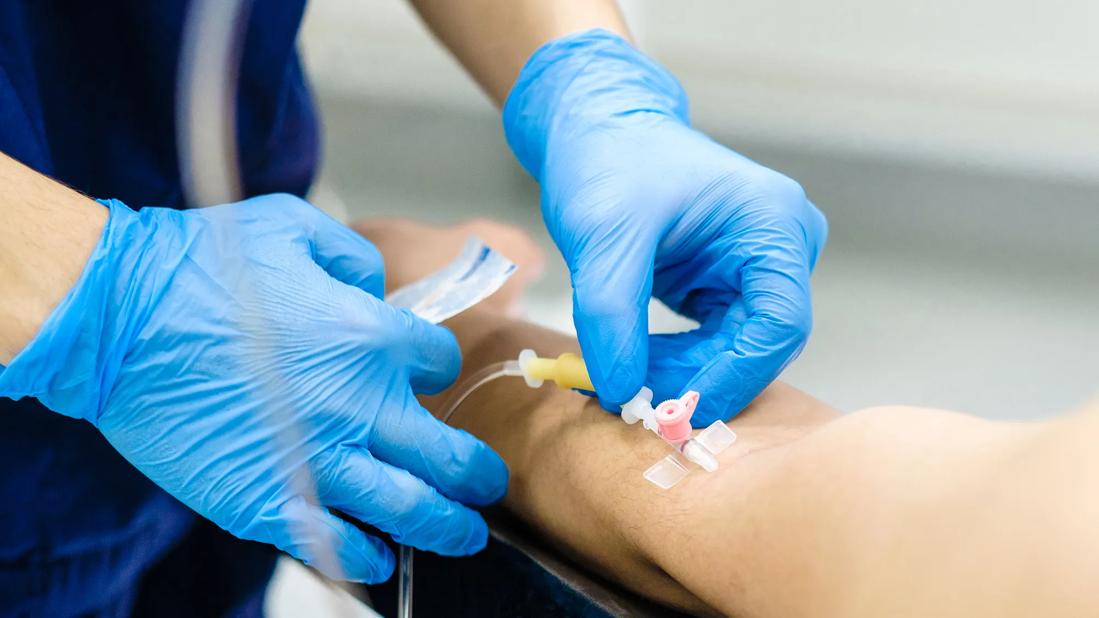Special skills course aims to improve patient safety and comfort while building caregiver confidence

Designed to teach best practices and empower caregivers to be “champions” for vascular access, Cleveland Clinic’s Vascular Access Resource Nurse (VARN) program has two simple goals: reduce the risk of central-line infections and improve patient safety.
Advertisement
Cleveland Clinic is a non-profit academic medical center. Advertising on our site helps support our mission. We do not endorse non-Cleveland Clinic products or services. Policy
“We like to say, ‘Every vein deserves world-class care,’” explains Joyce Brodnik, MSN, RN, CCRN-K, VA-BC, a Nursing Professional Development Specialist and VARN facilitator at Cleveland Clinic.
Established nearly two decades ago in response to concerns about the dangers of central line-associated bloodstream infections (CLABSIs), the VARN initiative recently received national recognition when it became the first such program to be awarded the Infusion Nurses Society Seal of Approval.
Since its inception, the program has made important strides in Cleveland Clinic’s ability to create and maintain more consistent, evidence-based vascular access practices, says Nursing Professional Development Specialist Migdalia Serrano-Smith, MSN, RN, VA-BC.
“I remember how empowered I felt when I first took the class,” recalls Serrano-Smith, who is now a VARN educator. “I very quickly realized that I had much to learn, and I jumped at the chance to improve patient outcomes with my newfound skills.”
Nurses who demonstrate a passion for vascular access and desire to become leaders in their practice area may be nominated by their manager to join the program. In addition to attending a four-hour workshop focused on the development of core vascular-access skills, trainees receive ongoing education and support through online resources and virtual modules. VARNs also participate in a refresher course every three years to stay on top of the latest best practices.
Brodnik notes that the VARN program helps attendees achieve competency, not certification. Participating nurses gain confidence not only in performing vascular-access procedures but also in educating their colleagues, says Serrano- Smith.
Advertisement
“Nurses leave the training ready to speak up, advocate for their patients and empower their fellow caregivers to foster best practices in vascular access,” she says.
There are currently more than 750 active VARNs across the Cleveland Clinic enterprise, many of whom act as go-to experts in their unit – answering questions about vascular access, providing support and mentorship to peers and teaching best practices to their less-experienced peers. These specially trained caregivers are also empowered to advocate for up-to-date vascular access protocols at the bedside, even if that means correcting a provider, Serrano-Smith notes.
“We teach our nurses that if they see something, they should say something,” she says.
Serrano-Smith also stresses the importance of education, explaining, “Every patient is affected by vascular access at some point during their hospital stay, and best practices continue to evolve as new evidence becomes available.”
Even the most experienced caregivers may be using outdated practices, she notes. Two decades ago, for example, it was common practice to use heparin to prevent clot formation in peripheral IVs.
“We don’t do that anymore — we use saline,” Serrano-Smith says. “We used to believe that anticoagulants prevented the formation of blood clots, but newer research shows that flushing the line actually solves the problem, not the medication.
Brodnik, who worked in critical care for more than two decades, says she has long had a passion for vascular access.
“Vascular access is an essential component of long-term medical care, so central lines are ubiquitous in hospitals,” she says. “These devices are literal lifelines – enabling everything from medication administration to fluid replacement to nutritional support – and I continue to admire their importance and versatility.”
Advertisement
Although she misses working directly with patients, Brodnik finds great, albeit different, rewards in training the next generation of nurses.
She recently heard from a VARN whose colleagues were refusing to use a patient’s vascular-access port because it was five years old. Thanks to the training she received, the nurse knew the device was safe to use, despite its age.
“I’ve found a different way to give back to our patients,” Brodnik says. “The VARN program supplies nurses with the knowledge they need to provide lifesaving care. By mastering vascular access skills, nurses are reducing the risk of infection, complications and discomfort. It’s a great feeling to know that the greatest beneficiaries of their expertise will be Cleveland Clinic’s patients.”
Advertisement
Advertisement

An unexpected health scare provides a potent reminder of what patients need most from their caregivers

Cleveland Clinic Abu Dhabi initiative reduces ICU admissions and strengthens caregiver collaboration

Veteran nurse blends compassion, cutting-edge transplant training and military tradition to elevate patient care

Embrace coaching and other tips to be a stronger leader

Compassion, communication and critical thinking are key

Study illuminates value of shared decision-making

How hospitals can weave ethics into daily nursing practice to strengthen patient-centered care

Mobility carts provide exercises and tools